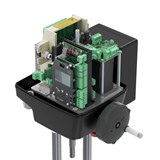Brushless DC technology is making electric actuators more efficient, more adaptable, and more connected—and changing expectations for what an actuator can do. As process engineers consider new electric actuators, they should consider BLDC models like the CIRCOR RTK REact DC to unlock efficiency and future-proof their systems.
Next generation electric actuators utilize brushless DC technology. BLDC motors are engineered without brushes, instead utilizing a “smart” motor management system to control rotation. With no space wasted on brushes, these compact motors can provide more power and torque in the same dimensions as their brushed counterparts. Without the friction, these actuator motors also require much less maintenance. The brushless design of the RTK REact DC enables 100% running time.
Likewise, if flow conditions require less torque, the BLDC motor can reduce the amount of energy it uses. These “smart” motors can independently match speed and torque to conditions. As a result, BLDC motors such as the RTK REact DC can reduce energy consumption by over 60% compared to synchronous motors.
The hardware of today’s BLDC actuator models enables connectivity now and in the future. Cutting-edge integration—REact DC actuators feature Profibus, and CAN-open integration—will surely be usurped by future communication systems, and “smart” actuators will require little retrofitting to function in these new networks. In the context of market growth driven by the desire to connect, the flexibility of the REact DC reveals its most salient advantage here: whether one designs a network connected by USB to a central computer or to function with a mobile app using QR codes, the BLDC actuator is a programmable tool able to deliver efficient actuation force according to changeable parameters.
Courtesy of CIRCOR.


